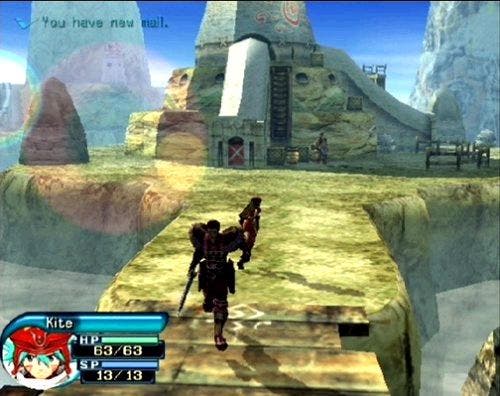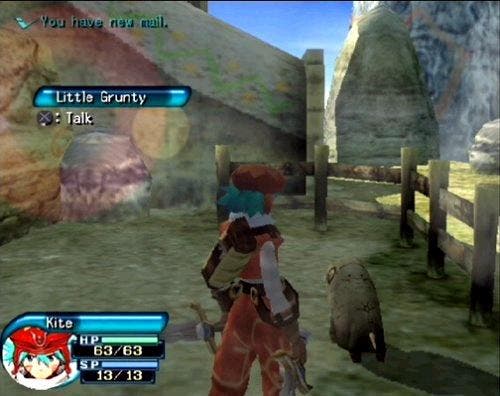.hack//INFECTION (Part 1)
Rob catches the bug.
There aren't a lot of games around these days which can be described as "high concept", but once we'd got our head around the basic idea behind .hack//INFECTION - the first of four consecutive volumes in the .hack story, and it's pronounced "dot hack slash infection" if you're wondering - we were convinced that we'd found one. It's not often, after all, that you get your hands on a game where your little on-screen pal is playing a videogame. A massively multiplayer online videogame at that, although in fact .hack is resolutely single-player and there's not a network adapter in sight.
Oh dear. Some explanation may be required.
Massively Single-player Offline Game

In fact, the premise behind .hack is simple enough at heart. At some point in the future, an online role-playing game called The World has become the most popular game on earth, and you're invited to join in the game by a friend (in-game name: Orca), who is a very high level character online. No sooner have you joined the game, however, than strange things start happening - some of which have very real and very severe consequences in the outside world. From here on, it's up to you to investigate what's going on and try to solve the mystery behind The World, and the best way to do that is within the game itself, by exploring the game world and conversing with other players.
The real quirk behind .hack, however, is that it's not limited to in-game interactions with players. You can choose to exit The World at any time, at which point you're dropped back to the desktop of an operating system called Altimit, allowing you to read email or news, browse web forums and even customise your desktop background images and music. You launch The World from this desktop in the same way as any other application. This is the nerve centre for your communications - here you search for information to help in your quest, chat to other players over email and gradually unravel the mysteries surrounding The World.
One of the biggest achievements of .hack is that it manages to make all of this fit together coherently and makes the people you play with in the game seem almost real. Within the game, you can chat to or trade with just about any character, and they all have different personalities - many of which evolve over the course of the game. Characters you play with will often email you outside the game, sometimes with information directly related to the plot, but usually just for a chat - with the result that I've had conversations with my party members over email on topics as diverse as school sports classes, samurai movies and apple pies. Mini flame wars even occasionally break out on the web forums, and there's useful information about side quests to be gained from them.
Hack 'n Slash

It would be unfair to describe all of this as window dressing, because it really is a vital part of the game - but once you're inside The World, the gameplay is actually fairly bog standard RPG fare. The game world is made up of countless environments, which you access by their segment address - a combination of three words from a set of word lists provided in the game. The word combination determines the type of area, in terms of difficulty level, terrain type, dungeon type, elemental alignment and so on. Most areas in the game are simply of the "clean out the dungeon, level up a bit and nick the treasure" variety - only certain segment addresses (usually provided on the board or over email) lead to genuinely interesting areas with plot elements or special items to be found.
Each server in the game (there are two in INFECTION, namely Delta and Theta - more servers open up in later volumes of .hack) also has a central town area with shops and services available, where you can talk to other players and assemble your party before going adventuring. You can have up to three people in your party, and once you have been given someone's member address you can call them up and bring them adventuring at any time - assuming they're online of course, which isn't always the case. Of course, you don't have direct control of your other party members - after all, they're meant to be other human players as well - but you can give them orders through a well thought out menu system, and they generally obey them pretty well (so not like a real online game at all, then).
Once inside a segment in the game, the gameplay is that of a remarkably simple dungeon-crawler. You run around the level, and then descend the floors of the subterranean dungeon, killing monsters that spawn in front of you in a real-time action RPG style combat mode (which thankfully pauses when you bring up menus to select special moves, magic or healing items), breaking boxes to find items and eventually either defeating the boss or opening the special chest at the end of the dungeon to get your payoff. Each dungeon is generated from a selection of pre-fabricated rooms and corridors, so although there are several different varieties of dungeon, ultimately they are full of remarkably similar rooms and architecture, which can make the game seem a bit tedious at points when the plot is a little slow.
Fly my Kite

Perhaps because of this prefabricated approach to building dungeons, .hack isn't the best looking game we've ever seen on the PS2. It certainly has its moments - like the first time you notice a massive shadow passing over the ground, look up and see giant floating islands flying overhead, or the extremely good-looking central hub cities of each server - but in general it's no challenger to the likes of Xenosaga or Final Fantasy X, and looks for all the world like a first generation PS2 title. The character designs are excellent however, created by the acclaimed character designer behind popular anime series Neon Genesis Evangelion, Yoshiyuki Sadamoto.
The game also boasts great music, and we were delighted to note that the US version comes with the ability to switch the game over to Japanese with English subtitles rather than having to listen to the English dubbed versions of the characters - an option the localisation teams on other RPGs or plot-heavy games should certainly take note of!
Ultimately, however, this is a game that lives or dies by the strength of its plot. The way it gradually reveals information to you and unravels the story behind The World is fascinating, and utterly different to anything we've encountered in a game before - and it's this unique plot device, along with the clever use of in-game banter between your party to build up the characters and a host of other well-implemented "fake multiplayer" features that rescue .hack from being a worthy but ultimately tedious dungeon crawler.
The game is also enhanced significantly by the inclusion of a DVD, .hack//LIMINALITY, which covers some of the events in the real world during the course of the game. It's a nice touch which really helps to draw the player into the storyline of this chapter of the .hack story, and this kind of cross-media experience is one which we experience all too infrequently over here. Two other TV series - namely .hack//SIGN (set before the events of the games) and .hack//Legend of Twilight's Bracelet (also called .hack//DUSK, and set long after the events of the games) also exist within the storyline of .hack, so if you're drawn in by the plot there's plenty to explore once you've finished.
Now Turn the Page
Of course, the fact is that .hack//INFECTION is only the first of four volumes of a huge story, and to get the entire story you'll need to acquire all four. That's not necessarily a bad thing - INFECTION alone comprises a good thirty hours of gameplay if you're trying to complete all the side tasks, and it does let you run around in the game levelling up and finishing quests even after the main plot of the chapter is resolved, so you can get your characters all kitted out before importing them into chapter two.
The real test of .hack//INFECTION is whether the plot and characters could make us yearn for another thirty hours of the same gameplay, even despite our misgivings about the dungeon crawler style gameplay. The answer to that question is a resounding yes - the second volume, .hack//MUTATION, was in the PS2 DVD drive without hesitation almost as soon as we'd cleared out the first volume. If that's not a recommendation, we don't know what is.

